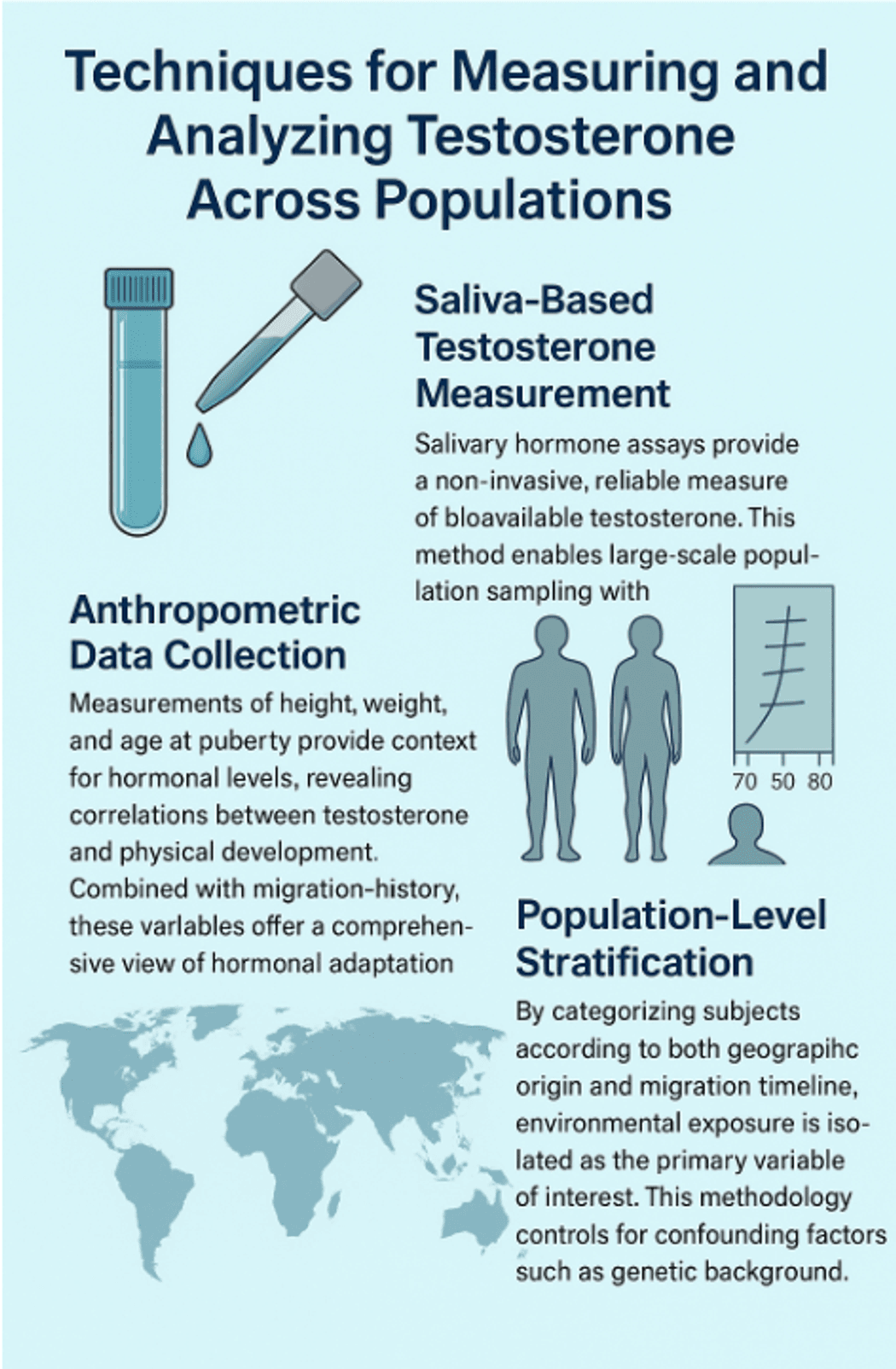Introduction: Understanding Testosterone Levels by Country and Childhood Environment
Testosterone, the principal male sex hormone, governs vital physiological functions including reproductive development, muscle strength, bone integrity, and overall metabolic health. For years, researchers have debated the influence of genetics and ethnicity on testosterone levels. However, groundbreaking research is shifting focus toward environmental factors, particularly those experienced during childhood, as a dominant influence on hormonal development.
When evaluating testosterone levels by country, common assumptions often highlight hereditary traits or cultural lifestyle differences. Yet, new findings indicate a stronger link between testosterone and environmental exposures such as nutritional quality and infectious disease burden during formative years. A recent study from Durham University reveals that early-life surroundings play a decisive role in determining adult testosterone levels, challenging long-held beliefs and reframing how regional hormonal profiles are interpreted across global populations.
Testosterone Variation Study Design: Insights from Comparative Anthropological Analysis
Researchers collected data from 359 men of Bangladeshi and European descent, distributed across varying childhood and adult environments. Saliva samples were used to assess testosterone levels alongside measurements such as height, weight, and age at puberty onset.
Sample Groups
The study divided participants into five cohorts:
Bangladeshi men raised and residing in Bangladesh
Bangladeshi men who migrated to the UK as children
Bangladeshi men who migrated to the UK as adults
Second-generation UK-born Bangladeshis
UK-born ethnic European men
This approach allowed for a nuanced evaluation of how early-life conditions, rather than ethnicity or adult location, influence hormonal profiles.
Key Findings on Testosterone Levels: Childhood Environment vs. Ethnic Background
Childhood Infection and Nutritional Stress
The research found a clear gradient in testosterone levels that correlated with the childhood environment. Men raised in the UK, including those of Bangladeshi origin, had significantly higher testosterone levels than those raised in Bangladesh. These higher levels were accompanied by earlier onset of puberty and increased height.
The study posits that high testosterone production demands a high energy investment, which may not be sustainable in environments burdened by infectious diseases or limited nutrition. In such settings, the body prioritizes energy toward survival rather than reproductive development.
"A man's absolute levels of testosterone are unlikely to relate to their ethnicity or where they live as adults but instead reflect their surroundings when they were children." — Dr. Kesson Magid, Durham University
Hormonal Plasticity During Development
According to the findings, aspects of male reproductive development remain flexible until late adolescence, around age 19. This suggests a critical window where environmental factors can shape long-term endocrine profiles.
"Very high and very low testosterone levels can have implications for men's health and it could be important to know more about men's childhood circumstances to build a fuller picture of their risk factors for certain conditions or diseases." — Professor Gillian Bentley, Durham University
Tools and Techniques: Methods Behind the Findings

Techniques for measuring and analyzing testosterone across populations
OpenAI (2025)
Saliva-Based Testosterone Measurement
Salivary hormone assays provide a non-invasive, reliable measure of bioavailable testosterone. This method enables large-scale population sampling with minimal discomfort to participants.
Anthropometric Data Collection
Measurements of height, weight, and age at puberty provide context for hormonal levels, revealing correlations between testosterone and physical development. Combined with migration history, these variables offer a comprehensive view of hormonal adaptation.
Population-Level Stratification
By categorizing subjects according to both geographic origin and migration timeline, the study isolates environmental exposure as the primary variable of interest. This methodology controls for confounding factors such as genetic background.
Health Implications of Testosterone Levels: Environmental Risk Factors and Global Patterns
Clinical Relevance of Testosterone Levels
High testosterone levels have been linked to increased muscle mass, heightened aggression, and elevated risks for prostate disorders, including benign prostatic hyperplasia (BPH) and prostate cancer. Conversely, low levels may result in fatigue, reduced libido, and erectile dysfunction. Notably, all participants in the study remained within fertility-viable ranges.
Advanced Lab Management Certificate
The Advanced Lab Management certificate is more than training—it’s a professional advantage.
Gain critical skills and IACET-approved CEUs that make a measurable difference.
Understanding testosterone levels by country through the lens of early environmental exposure may improve risk assessments for hormone-related health issues. It emphasizes the need to consider developmental history in clinical screenings and not just adult lifestyle or genetics.
Global Health and Migration Studies
This research also contributes to the broader field of migrant health studies. Second-generation individuals often exhibit physiological traits more aligned with their country of residence than their ancestral homeland, demonstrating how early-life environments override genetic predispositions.
Summary Table: Testosterone and Environmental Influence
| Group | Childhood Location | Adult Location | Testosterone Levels | Puberty Onset | Height |
|---|---|---|---|---|---|
| 1. Bangladesh-native | Bangladesh | Bangladesh | Lower | Later | Shorter |
| 2. Childhood Migrant | Bangladesh -> UK | UK | Higher | Earlier | Taller |
| 3. Adult Migrant | Bangladesh | UK | Lower | Later | Shorter |
| 4. UK-born Bangladeshis | UK | UK | Higher | Earlier | Taller |
| 5. UK-born Europeans | UK | UK | Higher | Earlier | Taller |
Conclusion: Rethinking Hormone Determinants Across Borders
The Durham University study dismantles the long-standing assumption that testosterone variability is primarily dictated by race or genetic inheritance. Instead, it highlights the critical importance of childhood environments in shaping lifelong hormonal profiles. For researchers, clinicians, and public health officials, these insights call for a recalibration of how hormonal risk factors are assessed, with greater emphasis on early-life exposure to disease, nutrition, and stress.
Frequently Asked Questions (FAQ)
1. Does genetics have any influence on testosterone levels?While genetics play a role, this study shows that early environmental conditions—such as exposure to disease and nutrition during childhood—are more significant in determining adult testosterone levels.
2. Can testosterone levels change in adulthood based on current environment?According to the research, testosterone levels become relatively fixed by late adolescence. Adult environments have minimal influence compared to childhood conditions.
3. Why do men raised in the UK show higher testosterone levels?Men raised in the UK had access to better healthcare, nutrition, and lower disease burden during childhood, allowing greater energy investment into reproductive development, resulting in higher testosterone levels.
4. How does this research impact clinical assessments of men’s health?It suggests that doctors should consider a patient’s early-life environment when evaluating hormonal health risks, particularly for conditions linked to abnormal testosterone levels. dismantles the long-standing assumption that testosterone variability is primarily dictated by race or genetic inheritance. Instead, it highlights the critical importance of childhood environments in shaping lifelong hormonal profiles. For researchers, clinicians, and public health officials, these insights call for a recalibration of how hormonal risk factors are assessed, with greater emphasis on early-life exposure to disease, nutrition, and stress.
As global migration continues to blur the lines of ethnic geography, understanding testosterone levels by country becomes less about nationality and more about the developmental journey. This paradigm shift has the potential to improve predictive models for male health outcomes and deepen our understanding of human physiological adaptability.













